Bell Food Group Bundle
Can Bell Food Group Sustain Its Growth Trajectory?
Explore the dynamic world of Bell Food Group, a Swiss Food Company that has transformed from a local butcher shop into a European food industry leader. This analysis dives into the company's strategic evolution, from its inception in 1869 to its current market position, highlighting its resilience and adaptability. Discover how Bell Food Group has navigated the complexities of the Meat Processing and convenience food sectors.
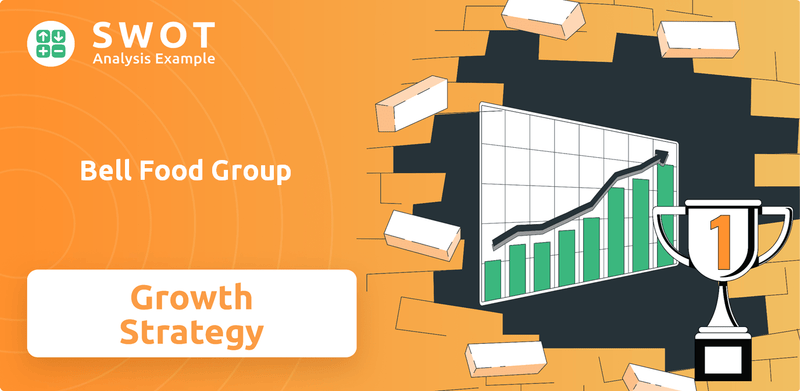
Bell Food Group's Bell Food Group SWOT Analysis reveals how the company has achieved consistent organic growth, even in competitive markets. With a focus on strategic expansion and innovation in food, the company is poised for continued success. This report examines Bell Food Group's market share, financial performance, and its commitment to sustainability initiatives, providing insights into its future outlook and investment opportunities within the food industry.
How Is Bell Food Group Expanding Its Reach?
The Bell Food Group is actively executing several expansion initiatives to enhance its market presence and diversify its product range. The company's growth strategy focuses on increasing value-added depth, particularly within the sliced charcuterie segment. This is supported by capacity expansions, such as the addition of slicing lines by Bell International.
A key element of the Bell Food Group's strategy involves reinforcing its convenience food operations. This segment demonstrated positive momentum and significantly contributed to growth in 2024. For instance, Hilcona, a brand under the group, experienced sales revenue growth driven by fresh meals and tofu in 2024. Similarly, Eisberg successfully launched a 'freshly made' fruit range in Switzerland and Austria, achieving sales of one million cups within the first nine months of 2024.
Geographical expansion is also a crucial component of Bell Food Group's strategy. Bell Germany continues its positive sales volume trend, while Bell Spain has increased both domestic and export sales volumes. Bell Poland is enhancing its value-added through strong niche production, and Bell France is also reporting success. The poultry business, Hubers/Sütag, which became an independent business area in June 2024, is aiming for further expansion due to strong demand, especially for organic poultry. The company has recently invested in additional capacity for sliced charcuterie to meet this demand.
The company is expanding its production capacity, especially in the sliced charcuterie segment. Bell International has added new slicing lines to support this growth. This strategic move aims to increase the value-added depth of its product offerings and meet rising consumer demand.
The convenience food sector is a key area of focus, with positive momentum driving growth. Hilcona, a brand within the group, saw sales growth in 2024 due to fresh meals and tofu. Eisberg's 'freshly made' fruit range also contributed significantly, selling one million cups in the first nine months of 2024.
The company is expanding its presence in key markets. Bell Germany and Bell Spain are experiencing positive sales trends. Bell Poland is focusing on niche production, and Bell France is also seeing success. This expansion strategy supports the company's overall growth objectives.
Hubers/Sütag, the poultry business, is expanding due to strong demand, especially for organic poultry. The company invested in additional capacity for sliced charcuterie. This expansion reflects the company's commitment to meeting consumer demand and growing its market share.
While expanding, Bell Food Group is also optimizing its portfolio. In May 2025, Eisberg announced the sale of three production sites in Poland, Romania, and Hungary to Green Factory. This move is designed to streamline operations and concentrate on core markets within the DACH region.
- The sale of production sites in Poland, Romania, and Hungary to Green Factory.
- Focus on core markets in the DACH region (Germany, Austria, and Switzerland).
- Enhancement of operational efficiency and consolidation of resources.
For a deeper understanding of the company's financial structure and business model, consider exploring the Revenue Streams & Business Model of Bell Food Group.
Bell Food Group SWOT Analysis
- Complete SWOT Breakdown
- Fully Customizable
- Editable in Excel & Word
- Professional Formatting
- Investor-Ready Format
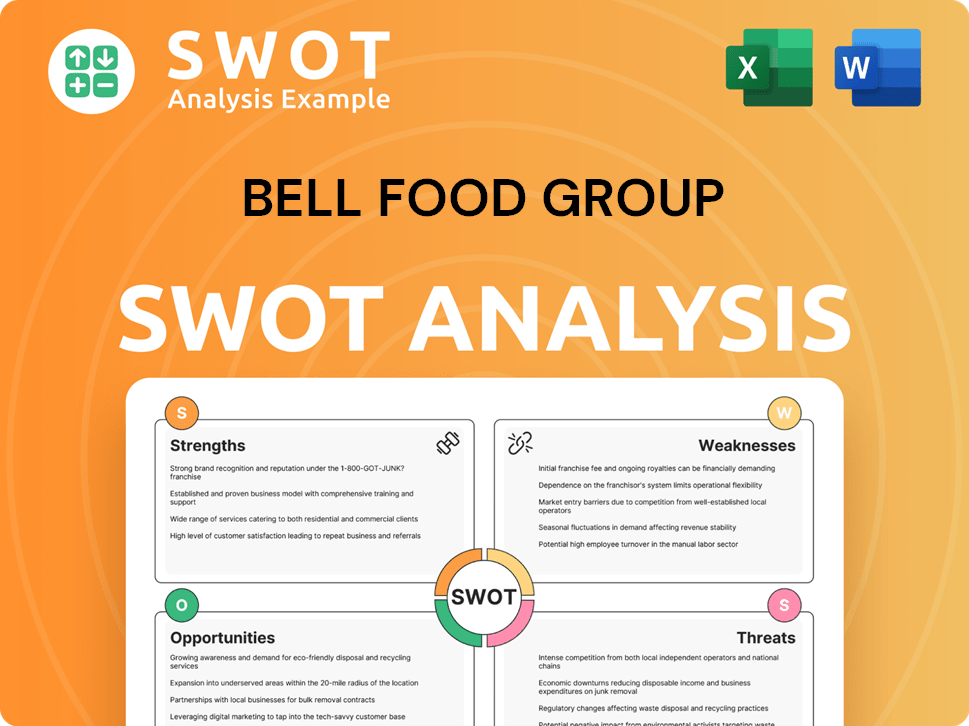
How Does Bell Food Group Invest in Innovation?
The Bell Food Group is actively embracing innovation and technology to drive its growth strategy and maintain its competitive edge within the food industry. This approach includes a strong focus on digital transformation and investments in research and development.
The company is modernizing its operations and IT infrastructure to streamline processes and enhance efficiency. This commitment to technological advancement is evident in various initiatives, from e-commerce solutions to sustainable facility developments.
Furthermore, Bell Food Group's dedication to sustainability is integrated into its innovation strategy. The company is implementing measures to reduce its environmental impact, such as expanding solar energy use and setting ambitious climate targets.
The IT division, Bell Neuvotech, is crucial in digital transformation, offering services like e-commerce application development and ERP solutions.
This digitalization extends to website design and mobile app development, indicating a comprehensive approach to modernizing the entire value chain.
Bell Food Group is integrating process automation through machine learning to enhance operational efficiency.
New digital functions are being developed to support recipe development, including requirements management and compliance checks.
Significant investments are made in R&D and new facilities to support Bell Food Group's growth strategy.
A new cattle slaughterhouse in Oensingen, Switzerland, is set to open in summer 2025, focusing on animal welfare, hygiene, and energy efficiency.
Hilcona's facility development includes a new drainage concept and a sustainable wastewater treatment plant.
State-of-the-art photovoltaic systems are being implemented, with commissioning scheduled for the second half of 2025.
In 2024, Bell Food Group installed seven new photovoltaic systems across various locations in Germany, Austria, and Switzerland.
This initiative demonstrates a commitment to expanding the use of solar energy to reduce its carbon footprint.
Bell Food Group is implementing tailored energy efficiency measures, including energy-efficient production technologies and LED lighting.
The company has science-based climate targets, aiming to reduce operational greenhouse gas emissions by 21% by 2026.
Product innovations in 2024 included fine-tuning national specialties with sustainable packaging that saves 37% plastic and launching 24 barbecue innovations.
Hilcona successfully introduced poké bowls and an oriental cuisine concept, expanding its product portfolio. For more insights into the company's values, explore the Mission, Vision & Core Values of Bell Food Group.
- The 'wafer-thin slices' concept for Bell International in Germany was developed.
- These innovations reflect Bell Food Group's commitment to sustainability and market responsiveness.
- The company aims to achieve 'climate neutrality in operations' by 2035, demonstrating its long-term sustainability initiatives.
- These initiatives are part of Bell Food Group's comprehensive growth strategy analysis, focusing on both financial and environmental performance.
Bell Food Group PESTLE Analysis
- Covers All 6 PESTLE Categories
- No Research Needed – Save Hours of Work
- Built by Experts, Trusted by Consultants
- Instant Download, Ready to Use
- 100% Editable, Fully Customizable
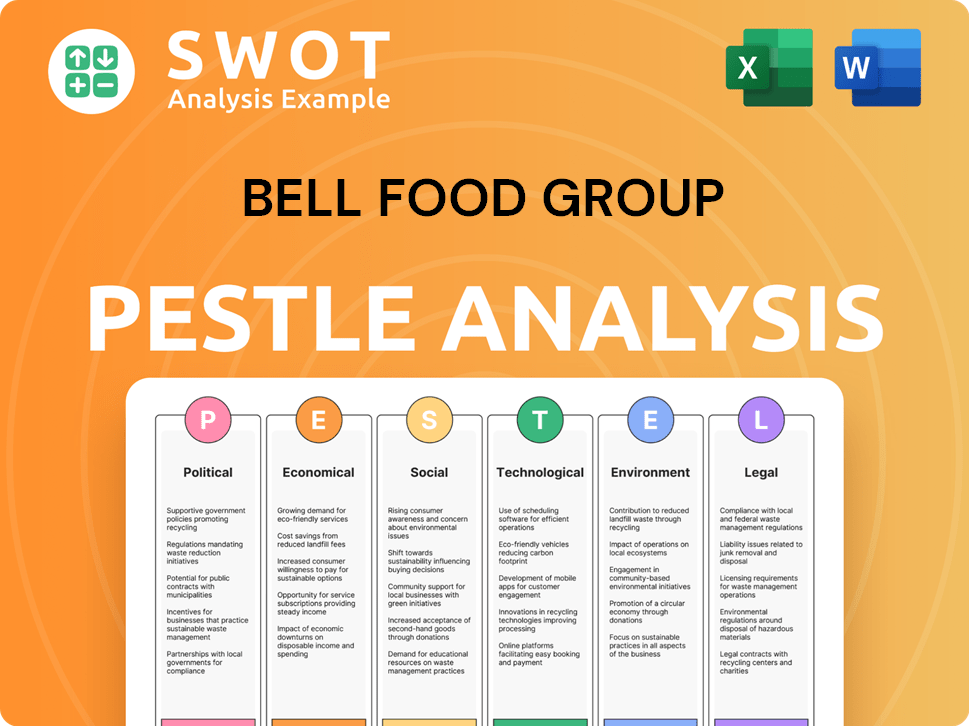
What Is Bell Food Group’s Growth Forecast?
The financial outlook for Bell Food Group reflects a positive trajectory, with the company demonstrating robust financial performance in 2024. The Swiss Food Company has shown consistent growth, which is a key indicator of its strong market position and effective growth strategy. This performance underscores the company's ability to navigate the complexities of the food industry and capitalize on opportunities for expansion.
In 2024, the company's net revenue from continuing operations reached approximately CHF 4.73 billion (US$5.23 billion), marking a 5.7% increase when adjusted for foreign exchange and acquisition effects. This growth is a testament to the company's strategic initiatives and operational efficiency. The Meat Processing segment, in particular, has likely contributed significantly to this revenue increase.
The company's financial performance is further highlighted by its operating profit (EBITDA), which grew by 3.6% to CHF 351 million. Despite facing higher taxes and interest expenses, the annual result for 2024 reached CHF 123.7 million. These figures demonstrate the company's resilience and its ability to maintain profitability in a competitive market. For a deeper understanding of the ownership structure and its impact, consider reading about Owners & Shareholders of Bell Food Group.
Net revenue for 2024 was approximately CHF 4.73 billion (US$5.23 billion), a 5.7% increase adjusted for foreign exchange and acquisition effects. This growth showcases the company's successful market strategies and operational efficiency.
EBITDA increased by 3.6% to CHF 351 million. This indicates strong operational performance and effective cost management within the company.
The annual result for 2024 was CHF 123.7 million. Despite increased financial burdens, the company maintained a solid profit margin.
As of May 28, 2025, the stock price was $316.64, with a market capitalization of $1.99 billion, reflecting investor confidence.
The company is focused on organic growth and gaining market share in saturated markets. This strategic approach is key to its long-term success.
Bell Food Group aims to further improve its profitability. This involves optimizing operations and enhancing efficiency across its business segments.
The company is intensifying its focus on convenience areas. This includes expanding its product offerings in ready-to-eat and easy-to-prepare food categories.
The Board of Directors proposed an ordinary dividend of CHF 3.50 gross per registered share for 2024. This reflects the company's commitment to shareholder value.
The company's investment program is proceeding as planned, with new facilities in Oensingen, Switzerland, expected to be commissioned in 2025. This will generate start-up costs and depreciation.
The proposed maximum amount for the compensation of the Group Executive Board for the 2026 financial year is CHF 4.9 million, consistent with the previous year.
Bell Food Group Business Model Canvas
- Complete 9-Block Business Model Canvas
- Effortlessly Communicate Your Business Strategy
- Investor-Ready BMC Format
- 100% Editable and Customizable
- Clear and Structured Layout
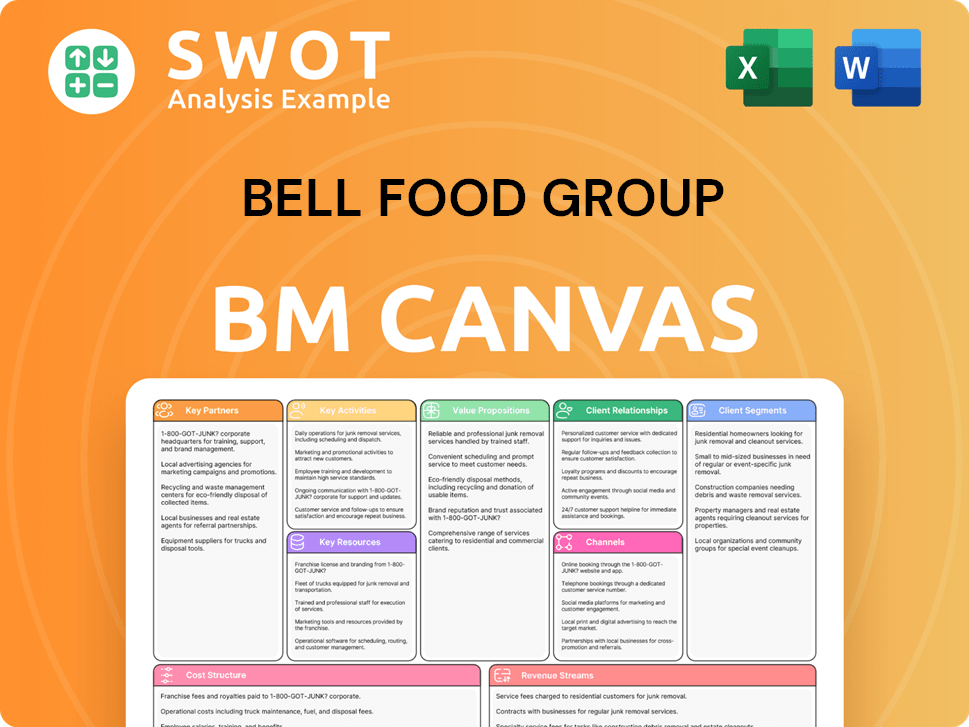
What Risks Could Slow Bell Food Group’s Growth?
The Bell Food Group faces several risks that could impact its growth strategy and future prospects in the food industry. These challenges range from intense market competition to supply chain vulnerabilities and the need for digital transformation. Addressing these obstacles is crucial for the Swiss food company to maintain its market position and achieve its expansion plans.
Competition in the food industry remains fierce, with many markets saturated, making it difficult for the meat processing company to gain significant market share. Consumer sentiment and shifting demand towards lower-priced products also pose a challenge, requiring the company to adapt its product portfolio. The company's financial performance is directly affected by these factors, necessitating strategic adjustments to maintain profitability.
Furthermore, the group must navigate supply chain vulnerabilities, including sourcing raw materials and managing rising operational costs. Technological disruption and the need for digital transformation also demand significant investments. For a deeper understanding of the company's origins and evolution, you can read Brief History of Bell Food Group.
The food industry is highly competitive. Growth often depends on gaining market share in saturated markets. The Bell Food Group must continually innovate and differentiate its offerings to stay ahead.
Consumer preferences are evolving, with a potential shift towards lower-priced products. This requires the company to adapt its product portfolio and pricing strategies. Understanding these trends is vital for the Bell Food Group's financial performance.
Sourcing raw materials, especially fruits and vegetables, can be challenging due to weather and quality issues. Price increases for raw materials and energy also impact operational expenses. The company's sustainability initiatives and supply chain management are critical.
Personnel costs and energy prices continue to rise, affecting operational expenses. The Bell Food Group must focus on efficient cost management to maintain profitability. This includes optimizing production processes and supply chain logistics.
Digital transformation requires significant investments in new technologies and IT infrastructure. The company must modernize its IT systems to support its growth strategy. This includes cybersecurity measures to protect the food supply chain.
Cybersecurity threats to the food supply chain are an emerging concern. The Bell Food Group must implement robust cybersecurity measures to protect its operations. This includes identifying vulnerabilities and improving protective measures.
The Bell Food Group employs systematic implementation of its business strategy, strong operating performance, and efficient cost management to address these risks. Diversification through a broad product range and a strong brand portfolio is also key. Ensuring a reliable system landscape, especially for SAP ERP systems, is critical to prevent disruptions.
Rising costs and market competition can impact profit margins. Investments in technology and new facilities require significant capital. The Bell Food Group must carefully manage its finances to maintain profitability and support its growth strategy. The ability to adapt to changing consumer preferences is crucial for long-term financial success.
Bell Food Group Porter's Five Forces Analysis
- Covers All 5 Competitive Forces in Detail
- Structured for Consultants, Students, and Founders
- 100% Editable in Microsoft Word & Excel
- Instant Digital Download – Use Immediately
- Compatible with Mac & PC – Fully Unlocked
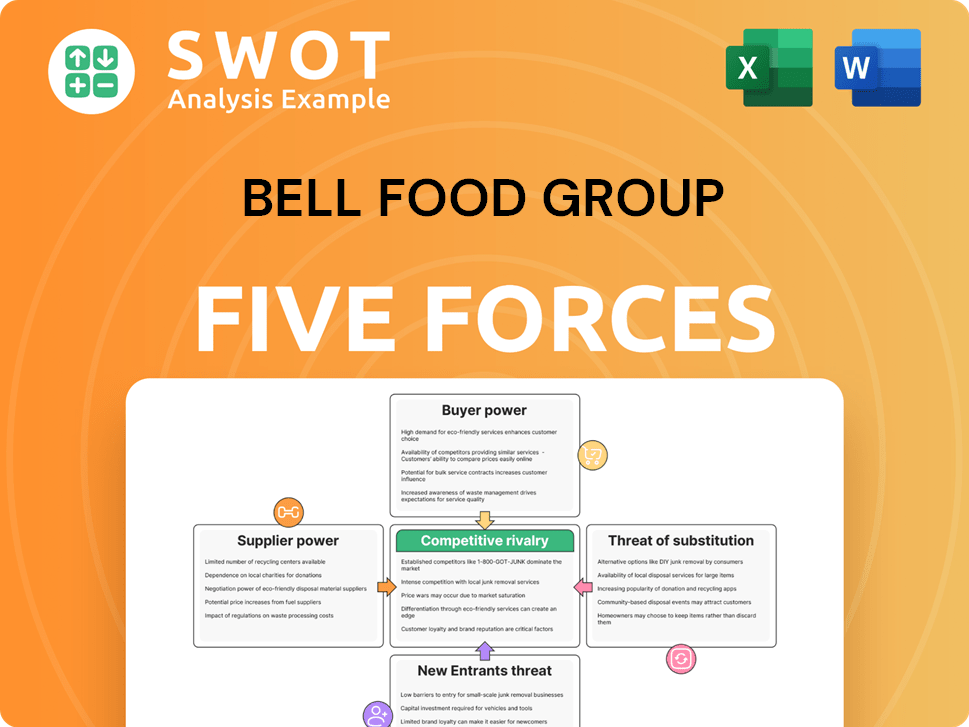
Related Blogs
- What are Mission Vision & Core Values of Bell Food Group Company?
- What is Competitive Landscape of Bell Food Group Company?
- How Does Bell Food Group Company Work?
- What is Sales and Marketing Strategy of Bell Food Group Company?
- What is Brief History of Bell Food Group Company?
- Who Owns Bell Food Group Company?
- What is Customer Demographics and Target Market of Bell Food Group Company?
Disclaimer
All information, articles, and product details provided on this website are for general informational and educational purposes only. We do not claim any ownership over, nor do we intend to infringe upon, any trademarks, copyrights, logos, brand names, or other intellectual property mentioned or depicted on this site. Such intellectual property remains the property of its respective owners, and any references here are made solely for identification or informational purposes, without implying any affiliation, endorsement, or partnership.
We make no representations or warranties, express or implied, regarding the accuracy, completeness, or suitability of any content or products presented. Nothing on this website should be construed as legal, tax, investment, financial, medical, or other professional advice. In addition, no part of this site—including articles or product references—constitutes a solicitation, recommendation, endorsement, advertisement, or offer to buy or sell any securities, franchises, or other financial instruments, particularly in jurisdictions where such activity would be unlawful.
All content is of a general nature and may not address the specific circumstances of any individual or entity. It is not a substitute for professional advice or services. Any actions you take based on the information provided here are strictly at your own risk. You accept full responsibility for any decisions or outcomes arising from your use of this website and agree to release us from any liability in connection with your use of, or reliance upon, the content or products found herein.